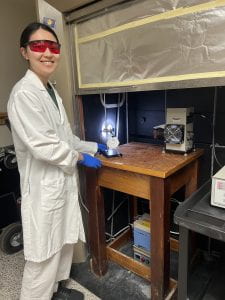
Setting up the apparatus for our sun lamp experiment
Author: Yibing Hu | Major: Finance | Semester: Spring 2023
Hi, my name is Yibing Hu and I am a Finance major in the Walton Honors program. I am also a part of the pre-med program at the University of Arkansas, which was a big factor in my decision to pursue STEM research. I have been working in Dr. Jingyi Chen’s chemistry lab with one of her graduate assistants, Elizabeth Reed, over the course of the Spring 2023 semester to demonstrate UV-based photocatalytic activity of titanium dioxide (TiO2) membranes on various dyes. We have also been experimenting with the efficacy of noble metals such as silver and copper in improving the stability of the TiO2 membranes. One potential application of my research lies in water purification, as UV light is a renewable energy source that is easy to obtain.
I began working with Dr. Chen and Elizabeth in Fall 2022. I started out helping with experimental setup and data collection, and in the process, I learned many common lab techniques. One of the projects Dr. Chen and Elizabeth were pursuing at the time, photocatalysis of methylene blue dye using TiO2 nanomembranes, piqued my interest and upon further discussion with Dr. Chen and Elizabeth, I decided to pursue it as a research topic.
Most things in science do not go perfectly. Over the past semester, we have had to adjust our experimental design to produce more accurate and reliable results. We started out using small UV light bulbs and recording the level of dye present at specified points in time. These results were inconsistent; it was difficult to assess whether the difference in dye concentration at two different time points was due to UV light exposure or passage of time. We also faced difficulties analyzing the data; we had been using a phone camera to take pictures of the dyed membranes. However, it was often difficult to tell with the naked eye whether the dye concentration had changed between two time points. Under Dr. Chen’s recommendation, we switched our light source to the sun lamp, which was much more powerful than our UV lights. Overexposure to the sun lamp can be dangerous, especially to the eyes, so we spent time preparing the lab space by covering the glass of a fume hood with foil and designing an apparatus to hold the membrane in place for exposure to the light. Also, to improve our data analysis, we decided it was best to use a gel electrophoresis imager to control exposure time and intensity of the light across various samples, and then analyze the results through Image J.
My mentor, Dr. Chen, as well as my graduate assistant, Elizabeth Reed, have played an integral part in my research. Dr. Chen kept us on track throughout the semester; during meetings, she would evaluate our progress and offer advice on what to change or improve. Having a mentor like Dr. Chen to turn to when I am uncertain about something has been reassuring; she never hesitates to lend her expertise. Elizabeth has taught me many relevant lab techniques, such as the TiO2 membrane synthesis, and thereby enabled me to work confidently. Additionally, she gave me guidance on what literature would help me better understand the scientific basis of my research.
The Honors College Research Grant has enabled me to pursue a fascinating research topic and gain valuable lab experience over the past semester. I have learned a great deal about the research process, including how to analyze scientific literature as well as how to be adaptive when coming across unexpected disruptions in the lab. Understanding the research process will help me as I continue to pursue this research topic over the Fall 2023 semester. Additionally, I am sure it will benefit me when I begin my Honors project for my Walton Honors requirement in the near future.
